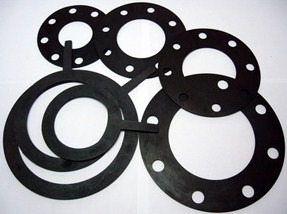Rubber gaskets are seals cut from rubber. The rubber gaskets is mainly used to prevent leakage of liquid and gas. The gasket is used, for example, as a filler between two pipes. Flange gasket is an example. Rubber deforms easily. Therefore, it is better to clamp the two parts to be joined together.
Rubber can close the space well under low surface pressure. In addition, rubber can be used on sloping surfaces because it is a flexible material. Various types of rubber seals are available. Each of these different types of rubber has its own specific properties.
View our gaskets here.
We do not have this product in stock. If you would like to order this product please submit a request in the form below.
NBR Gaskets:
NBR stands for Nitrile Butadiene Rubber. It is a wear-resistant gasket and is resistant to many substances, such as oil and diluted acids. The temperature range of the NBR gasket goes from -20 to 120 degrees Celsius, so the gasket is also suitable for outdoor use. NBR has a good resistance, by adding more acrylonitrile it becomes even more.
Viton Gaskets:
Viton is a type of rubber that deforms very quickly, faster than stainless steel. This ensures a good seal with the Viton gaskets. If you want to connect two stainless steel pipes, you can use a Viton gasket.
EPDM Gasket:
EPDM stands for Ethylene, Propylene, Diene and Monomer. It is a synthetic rubber with an elasticity of up to 400%. EPDM is resistant to the influences of the weather, ozone and UV radiation. It has a temperature range of -35 to 120 degrees Celsius. EPDM is also resistant to salts, acids and various bases.
SBR Gaskets:
Due to a simple rubber seal, it is best to opt for an SBR gasket. SBR has a temperature range of -30 to 70 degrees Celsius and is very wear-resistant, which means that the gasket lasts a long time.

